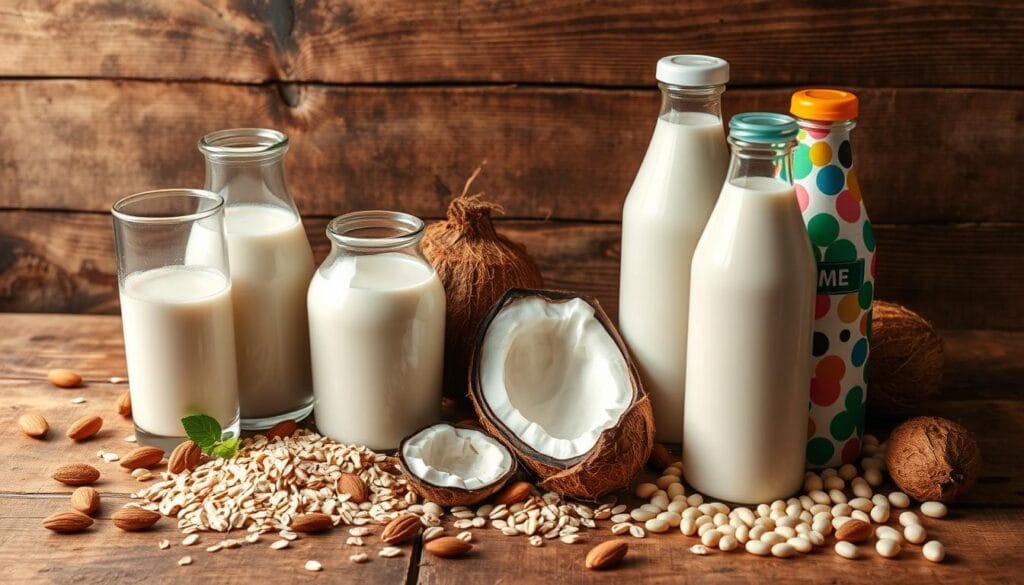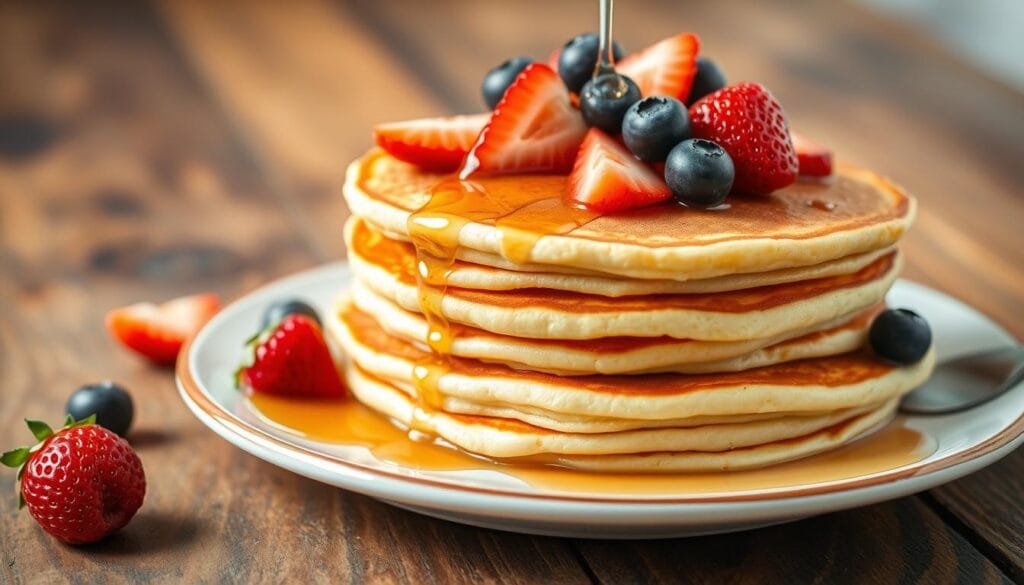Craving pancakes but need to avoid gluten or dairy? This guide is for you! We’ll show you how to make light, fluffy, and tasty gluten and dairy-free pancakes. They’ll satisfy your cravings and fit your dietary needs.
Got food allergies or just want a healthier breakfast? This guide is here to help. We’ll cover alternative flour and milk choices. Plus, we’ll share secrets for perfect texture and flavor. And, we’ll give you tips to make sure your pancakes are always perfect.
Key Takeaways
- Learn how to make delicious gluten and dairy-free pancakes at home
- Discover the best flour and milk alternatives for light and fluffy results
- Understand the health benefits of going gluten and dairy-free
- Explore natural binding agents and thickeners for the perfect texture
- Master the step-by-step mixing and cooking techniques
Why Choose Gluten and Dairy-Free Pancakes
Choosing gluten and dairy-free pancakes is great for your health. They’re perfect if you have gluten intolerance, lactose intolerance, or just want a healthier breakfast. These pancakes can really change your morning routine.
Health Benefits of Going Gluten and Dairy-Free
Gluten and dairy-free pancakes can help you avoid stomach problems and inflammation. They’re safe for those with celiac disease or gluten sensitivity. They’re also good for people with lactose intolerance, letting them enjoy pancakes without the usual issues.
Common Dietary Restrictions and Allergies
- Gluten intolerance
- Lactose intolerance
- Celiac disease
- Food allergies
Nutritional Advantages
Gluten and dairy-free pancakes are also better for you. They use different flours and non-dairy milk, making them more nutritious and often lower in calories. This makes them a great choice for a healthier breakfast.
“Embracing gluten and dairy-free pancakes can be a game-changer for your health and well-being.”
Essential Ingredients for Perfect Alternative Pancakes
Making delicious gluten and dairy-free pancakes needs careful ingredient choice. You’ll need more than just wheat flour and cow’s milk. There are many alternatives to get that perfect light and fluffy texture. Let’s explore the must-haves for your pancake recipe.
Gluten-Free Flour Blends
Your pancakes start with the right flour. Choose gluten-free flour blends. These mixes include rice, tapioca, or almond flour. They help your pancakes rise like regular ones.
Plant-Based Milk Alternatives
Use plant-based milk like almond, oat, or coconut milk instead of cow’s milk. These options make your pancakes creamy and rich. They’re also free from lactose and offer unique tastes and health benefits.
Egg Substitutes
If you don’t eat eggs, don’t worry. Egg substitutes like flax or chia seeds, aquafaba, or commercial replacers work great. They help your pancakes stay tender and together.
Leavening Agents
For fluffy pancakes, you need the right baking powder. Choose aluminum-free options or mix baking soda with lemon juice or vinegar. This combo gives your pancakes the perfect lift.
With these key ingredients, you’re ready to make gluten and dairy-free pancakes. They’ll be light, fluffy, and full of flavor.
Best Flour Alternatives for Light and Fluffy Results
Choosing the right flour is key to making delicious gluten and dairy-free pancakes. There are many great options besides traditional wheat flour. These alternatives can help you achieve pancakes that are light and fluffy.
Popular Gluten-Free Flour Blends
Pre-made gluten-free flour blends are a great choice. They often include almond flour, rice flour, and coconut flour. These blends are made to act like all-purpose flour, making baking easier.
Single-Grain Options
For a more personal touch, try using single gluten-free grains. Buckwheat flour and oat flour are good options. They add unique flavors and textures to your pancakes.
Creating Your Custom Flour Mix
Want total control over your pancakes? Mix your own gluten-free flour blend. Try different ratios of almond flour, rice flour, and buckwheat flour. This way, you can create the perfect mix for your pancakes.
“The key to light and fluffy gluten-free pancakes is finding the right flour blend. Don’t be afraid to get creative and try new combinations!”
Plant-Based Milk Options That Work Best
Choosing the right plant-based milk is key to making delicious gluten and dairy-free pancakes. Coconut milk is rich and creamy, while almond milk is light and versatile. Each milk has its own special qualities.
Soy milk is a great choice if you want something creamy like regular milk. It’s neutral in taste and thick, making pancakes fluffy and satisfying. Oat milk, on the other hand, adds a sweet and nutty flavor to the batter.
Rice milk is a light and refreshing option. It’s subtle, letting other flavors stand out. It’s perfect for those who want a neutral base.
The best milk for your pancakes depends on what you like and what you want your pancakes to be like. By trying different milks, you can make pancakes that are just right for you.

Getting the perfect pancake texture and flavor is all about finding the right mix of ingredients. This includes the plant-based milk you choose. With a bit of trial and error, you can make pancakes that are both tasty and fit your dietary needs.
Natural Binding Agents for Perfect Texture
Creating gluten and dairy-free pancakes that are light and fluffy is key. Luckily, there are many natural binding agents to help. From egg substitutes to thickeners, we’ll look at options for the perfect pancake texture.
Egg Substitutes
Looking for egg-free options? There are many plant-based binders. Flax eggs and chia seeds are favorites. You can also use applesauce or banana. For extra structure, try arrowroot powder or mix these ingredients.
Xanthan Gum and Other Binders
There are more binders than just eggs for gluten-free pancakes. Xanthan gum is great for preventing crumbling. Other options include psyllium husk, guar gum, and methylcellulose. They all help make pancakes light and cohesive.
Natural Thickeners
Want thicker, richer pancakes? Natural thickeners can help. Ground chia or flax seeds add body. Applesauce or mashed banana make them creamy. Try small amounts to get the right texture.
“The right combination of binding agents and thickeners can truly transform gluten and dairy-free pancakes, taking them from dense to delightfully light and fluffy.”
Step-by-Step Mixing Technique
Getting the right consistency in your gluten and dairy-free pancake batter is key for fluffy pancakes. Let’s explore the step-by-step mixing technique to help you get it right.
First, don’t over-mix the batter. Over-mixing can make pancakes tough and dense. Instead, mix the ingredients gently until they just come together, leaving a few lumps.
Start by whisking together your dry ingredients – like gluten-free flour, baking powder, and spices. Then, mix your wet ingredients, such as plant-based milk and pancake batter consistency, in another bowl.
- Pour the wet ingredients into the dry ingredients slowly. Use a rubber spatula to gently fold them together. Stop mixing when the batter just comes together, avoiding over-mixing.
- Let the batter rest for at least 15 minutes before cooking. This resting time helps the batter thicken and the gluten-free flours hydrate. It makes the batter smoother and more over-mixing texture.
By following this simple mixing technique, you’ll make perfectly light and fluffy gluten and dairy-free pancakes every time.
Temperature and Cooking Tips for Perfect Results
To make perfect gluten and dairy-free pancakes, pay close attention to temperature and cooking methods. Getting these right will make your pancakes light, fluffy, and golden-brown on the outside.
Perfect Heat Settings
For evenly cooked pancakes, keep your non-stick pan or griddle at the right temperature. Aim for medium-high heat, around 350°F to 375°F (175°C to 190°C). This helps the batter cook evenly without burning the outside.
Pan Selection and Preparation
Use a non-stick pan or griddle big enough for several pancakes at once. Lightly grease the surface with oil or non-stick spray to prevent sticking. Don’t over-grease, as it can cause uneven cooking and messy pancake bubbles.
Timing Your Flips
Flip your pancakes when pancake bubbles start to show and the edges turn golden brown. This usually takes 2-3 minutes per side. Don’t flip too early, as it can make the pancakes fragile and torn. Flip gently with a spatula to keep them soft.
“Achieving light and fluffy gluten and dairy-free pancakes is all about finding the right balance of temperature and cooking technique.”
Troubleshooting Common Problems
Making the perfect gluten and dairy-free pancakes can be tricky. But, with the right tweaks, you can fix common problems. This way, you’ll get the pancake texture, pancake taste, and pancake appearance you want. Let’s look at some easy fixes for common issues.
Gummy or Dense Texture
Is your pancake too gummy or dense? It might be because you mixed the batter too much or used too much flour. Try mixing just until everything is combined. Use less flour or a lighter gluten-free mix. Adding a bit of xanthan gum can also help with the pancake texture.
Lack of Flavor
Gluten and dairy-free pancakes might not taste as rich as traditional ones. To add flavor, add a teaspoon of vanilla extract, cinnamon, or a pinch of salt. Using a mix of gluten-free flours, like almond and coconut, can also enhance the pancake taste.
Uneven Cooking
Getting pancakes to cook evenly can be tough, especially with different ingredients. Make sure your pan or griddle is hot enough. Don’t flip the pancakes too often. Cooking them for 2-3 minutes on the first side helps them cook evenly.
| Problem | Possible Cause | Solution |
|---|---|---|
| Gummy or Dense Texture | Over-mixing or too much flour | Mix batter gently, use less flour or a lighter gluten-free blend, add xanthan gum |
| Lack of Flavor | Bland ingredients | Add vanilla, cinnamon, salt, or use a blend of gluten-free flours |
| Uneven Cooking | Incorrect heat setting or over-flipping | Preheat pan/griddle properly, let pancakes cook 2-3 minutes before flipping |
By fixing these common problems, you’ll make delicious, light, fluffy and tasty gluten and dairy-free pancakes. They’ll meet your cravings and dietary needs.

Delicious Topping Ideas
Make your gluten and dairy-free pancakes even better with tasty toppings. There’s more than just maple syrup to try. Discover a variety of flavors that everyone can enjoy.
Dairy-Free Sauces and Spreads
Try creamy coconut whipped cream or tangy fruit compote for a fancy touch. For something savory, drizzle smooth nut butter or a homemade maple syrup glaze.
Fresh Fruit Combinations
- Sliced bananas or berries for a burst of natural sweetness
- Diced mango, pineapple, or kiwi for a tropical flair
- Sautéed apples or pears for a warm, comforting touch
Nuts and Seeds Options
- Toasted coconut flakes for a crunchy texture
- Chopped almonds, pecans, or walnuts for a nutty crunch
- Sprinkle of chia or flax seeds for added nutrition
There are countless ways to make your gluten and dairy-free pancakes special. Try different toppings to find your favorite mix of flavors and textures.
Make-Ahead and Storage Solutions
Preparing your gluten and dairy-free pancakes in advance can save you time and effort. These pancakes are freezer-friendly, perfect for meal prep. Cook them, let them cool, and then stack them with parchment paper in between. Freeze them, and you’ll have freezer-friendly pancakes ready to reheat whenever you want.
There are a few ways to reheat these pancakes without losing their fluffiness. The easiest way is to microwave them, checking every 30 seconds to avoid drying. You can also warm them in a 350°F oven for 5-10 minutes.
Adding these meal prep-friendly pancakes to your routine can change your life. Enjoy them as a quick breakfast, a snack, or even as a base for savory meals. Having pre-made pancakes can make meal planning easier and save you time all week.

